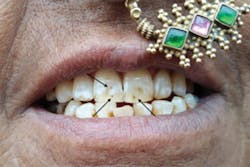Choumps and cultural tooth tattoos: Gold adornments penetrate enamel
By NANCY W. BURKHART, BSDH, EdD
Society has always adorned the body with jewels or clothing that identify the values or customs of a select group of individuals. Some customs are intertwined into the very fabric of a community.
For example, did you know that most people do not know why black clothing is worn for funerals? Many do not realize that this custom originated through death-related fear. Black clothing was worn as a disguise so that spirits would not return to earth and haunt the living. It was thought that if the person was not recognized by spirits, the evil spirits would not harm them.
Some customs continue to be passed down from generation to generation. Many customs are practiced unconsciously today, and many people do not really know why they adhere to these accepted rituals. Another example is that some adornments worn on the body - such as jewelry, precious stones, and body markings - may even promote a more utilitarian type of function, such as identification after death. Some cultures tattoo oral tissue so that the person may be identified among mass casualties.
Some unique societies see specific adornments as more of a rite of passage for young males and females. Many decorations have links to a segment within their own population, and certain tribes within a specific geographic area can be identified through esthetics. Even mutilation of the body is deemed an acceptable practice by some cultures. We have encountered body tattoos, oral soft tissue tattoos, piercings, and even oral piercings in recent years within the western world.
But what about tooth adornments? Adornment of the teeth is practiced within certain areas of the world.
Some geographic locations such as western Uttar Pradesh and Rajasthan in India practice what is called choumps. The choumps are rare tattoos made of gold and placed in the central incisors. The choumps vary from single gold dots to multiple dots in number and may be found in the centrals and sometimes the laterals of maxillary teeth. Individuals known as feruas visit villages during festivals and perform this task.
The holes that are drilled into the enamel are made with specific hand-held tools that drill into the tooth usually 0.5mm deep. After completion of the drilled hole, a gold wire is placed into the cavity and then hammered against the tooth. The gold is made very smooth as it is hammered and fitted into the space. This practice dates back thousands of years.
The choumps may also identify a particular tribe because of their unique appearance such as colored choumps, strategically placed choumps, and the varying number of choumps denote the tribe identity.. Gold is considered a pure metal, and it symbolizes truth. It is thought that a person with gold in their mouth will be honest and speak the truth. Kumar & Hemant (2007) wrote that there is historical evidence on the origin and myths of the practice, but many young generations may adhere to this practice just as a fashion statement. One of the “Five Tattvas,” according to the Hindu mythology, state that a person should carry five basic elements in his mouth at the time of his death, and one of these tattvas is gold. Yadav (2016) makes the point that, during the Mahabharata period in India, individuals who had gold tattoos were considered blessed by God.
The person who has the tattoo performed by the local tattoo maker may have some added risk since the instruments that are used are not sterilized and are just wiped down with a cloth. Multiple individuals may have the task performed in a single day with the same tools used on other clients. The tattoo maker ties a wrap around the jaw to steady the person so that movement is limited. No anesthetic is used during the procedure, but the choump is limited to the enamel surface so there may be limited discomfort. Some choumps are inserted shortly after the eruption of the central teeth in some communities. The hammering of the gold may be traumatic if the tattoo maker places too much force. The choumps are very helpful in forensic dentistry because they can identify specific groups within a tribe during a fire or bombing since the teeth are usually a remaining structure of the body.
The earth has not gotten any smaller, but the world has certainly become a much closer population, incorporating many different ethnic groups from all countries. The likelihood of encountering people from every corner of the globe is very high, and the dental professional must be prepared to recognize other cultural norms.
As always, continue to listen to your patients and ask good questions!
Author’s note: Thank you to Dr. Roma Yadav for providing insight into this subject matter and for answering my specific questions. RDH
NANCY W. BURKHART, BSDH, EdD, is an adjunct associate professor in the department of periodontics/stomatology, Baylor College of Dentistry and the Texas A & M Health Science Center, Dallas. Dr. Burkhart is founder and cohost of the International Oral Lichen Planus Support Group (dentistry.tamhsc.edu/olp/webcasts.html) and coauthor of General and Oral Pathology for the Dental Hygienist. She was awarded a 2016 American Academy of Oral Medicine Affiliate Fellowship (AAOMAF). She was a 2006 Crest/ADHA award winner. She is a 2012 Mentor of Distinction through Philips Oral Healthcare and PennWell Corp. She can be contacted at [email protected].
References
1. Burkhart NW. Culturally induced pigmented lesions. RDH. 2010; 30(6):56-57.
http://www.rdhmag.com/articles/print/volume-30/issue-6/columns/culturally-induced.html
2. Hans MK, Nagpal A, Shetty S. Choumps. Br Dent J. 2011 Sep 9;211(5):194.
3. Kumar CA, Hemant S. “Choumps” Enamel tattoos-revisted. J of Forensic Odonto-stomatology. 2007;25;61-62.
4. Yadav R, Yadav A, Radhika R, Pahuja M, Solanki S. Gold tooth tattoos: Identifying features in forensic odontology. J Clin Diagn Res. 2016 Jul; 10(7): ZJ08-9.


